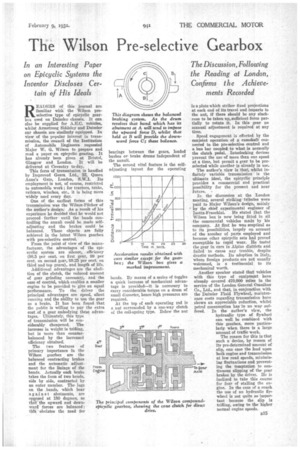The Wilson Pre-selective Gearbox
Page 49

If you've noticed an error in this article please click here to report it so we can fix it.
RFADERS of this journal arc familiar with the Wilson preselective type of epieyelic gearbox used on Daimler chassis. It can also be supplied for A.E.C. vehicles, whilst Armstrong Siddeley and Daimler car chassis are similarly equipped. In view of the popular interest in transmission the council of the Institution of Automobile Engineers requested Major W. G. Wilson to prepare and read a paper on epicyclic gearing. It has already been given at Bristol, Glasgow and London. It will be
delivered at Coventry to-day. •
This form of transmission is handled by Improved Gears. Ltd., 23, Queen Anne's Gate, London, S.W.1. Its employment is not, of course, restricted to automobile work ; for tractors, tanks, railcars, winches, etc., it is being more widely used every day.
One of the earliest forms of this transmission was the Wilson-Pilcher of the author's design. As a result of his experience he decided that he would not proceed farther until the bands controlling the annuli could be made selfadjusting and the brakes could he balanced. These objects are fully achieved in the latest Wilson gearbox with pre-selective control.
From the point of view of the manufacturer, the advantages of the epicyclic system are silence, efficiency (98.5 per cent, on first gear, 99 per cent on second gear, 419.25 per cent, on third and top gears), and length of life. Additional advantages are the abolition of the clutch, the reduced amount of gear grinding necessary, and the ease of control, which enables a smaller engine to be provided to give an equal performance. To the driver the principal advantages are speed, silent running and the ability to use the gear as a brake. It has been found that the public is willing to pay the extra cost of a gear embodying these advantages. Ultimately, this type of transmission will be considerably cheapened. The increase in weight is trifling, but is more than counterbalanced by the increased efficiency obtained.
The two features of primary importance in the Wilson gearbox sire the balanced contracting brakes and the automatic adjustment for the linings of the bands. Actually each brake takes the form of two bands, side by side, contracted by an outer member. The lugs on the bands, which bear against abutments, are ()Nosed at 180 degrees, so that the upward and downward forces are balanced ; this obviates the need for bearings between the gears, loaded bushes or brake drums independent of the annuli.
The second vital feature is the selfadjusting layout for the operating
hands. By means of a series of toggles a quick increase of mechanical advantage is provided—it is necessary to carry considerable torque on a drum of small diameter, hence high pressures are required. At the top of each operating rod is a nut surrounded. by a one-way clutch of the coil-spring type. Below the nut is a plate which strikes fixed projections at each end of its travel and imparts to the nut, if there should be any slackness to be taken up, sufficient force partially to rotate it. In this gear no manual adjustment is required at any time.
Speed engagement is effected by the conjoint operation of a camshaft connected to the pre-selective control and a bus bar coupled to what is normally the clutch_ pedal. Interlocking devices Prevent the use of more than one speed at a time, but permit a gear to be preselected while another is already in use. _ The author's view is that, whilst infinitely variable transmission is the ultimate ideal, the epieyclic principle provides a commercial and practical possibility for the present and near future.
In the discussion at the London meeting, several striking tributes were paid to Major Wilson's design, mainly by the chief experimental engineer of Isotta-Fraschini. He stated that the Wilson box is now being fitted in all the commercial vehicles made by his company. At first he was sceptical as to its possibilities, largely on account of the number of parts employed and because other epicyclic sets had proved susceptible to rapid wear. He tested the sear in cars in Alpine districts and failed to cause any trouble, despite drastic methods. Its adoption in Italy, where foreign products are not usually welcomed, is a testimonial to its mechanical worth.
Another speaker stated that vehicles with this type of equipment have already covered 470,000 miles in the service of the London General Omnibus Co., Ltd., and that, in conjunction with the Daimler Fluid Flywheel, maintenance costs regarding transmission have shown an appreciable reduction, whilst petrol consumption has in no way suffered. In the author's view, the hydraulic type of flywheel can well be combined with this gearbox, more particularly when. there is a large amount of traffic work.
The reason for this is that such a device, by reason of its pre-determined amount of slip, can ease the load upon both engine and transmission at low road speeds, minimie -Aee ing fluctuations and prevent
To Rent' jug the temptation to con
Axle Winans slipping of the gear brakes by the driver. He is inclined to take this course for fear of stalling the engine. In the case of a coach the use of an hydraulic flywheel is not quite so important because the slip is trifling, owing to the higher normal engine speeds.




























































































